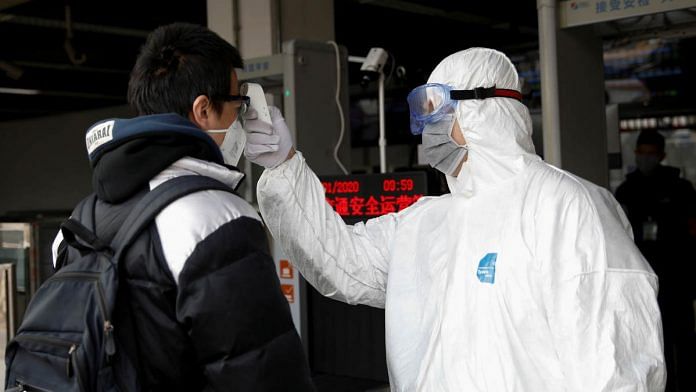Melbourne: The new coronavirus may have infected at least 1 in 20 people in Wuhan, the Chinese city at the epicenter of the global outbreak, by the time it peaks in coming weeks, according to scientists modeling its spread.
The typically bustling megacity, where the so-called 2019-nCoV virus emerged late last year, has been in lockdown since Jan. 23, restricting the movement of 11 million people. Trends in reported cases in Wuhan so far broadly support the mathematical modeling the London School of Hygiene & Tropical Medicine is using to predict the epidemic’s transmission dynamics.
“Assuming current trends continue, we’re still projecting a mid-to-late-February peak” in Wuhan, said Adam Kucharski, an associate professor of infectious disease epidemiology, in an email Sunday. “There’s a lot of uncertainty, so I’m cautious about picking out a single value for the peak, but it’s possible based on current data we might see a peak prevalence over 5%.”
Health authorities in China and around the world are anxiously waiting to know whether the world’s largest known quarantine has been effective in containing the pneumonia-causing virus in Wuhan and across other cities in Hubei province, the landlocked region of 60 million people.
Mapping the Coronavirus Outbreak Across the World
Kucharski, whose research focuses on the dynamics of infectious diseases, and colleagues have based their modeling on a range of assumptions about the 2019-nCoV virus. These include an incubation of 5.2 days, a delay from the onset of symptoms to confirmation of infection of 6.1 days, and the risk of infection among the 10 million people who have been identified as more vulnerable in Wuhan.
Based on that, a prevalence of 5% equates to about 500,000 cumulative infections. That’s many times more than the 14,982 cases provincial health authorities had counted in Wuhan as of 8 p.m. Saturday.
Antibody Test
Researchers will gauge the proportion of people in the population who have been infected with 2019-nCoV after a test becomes available enabling them to conduct a so-called serosurvey to identify those whose blood contains antibodies produced in response to exposure to the virus.
Currently, the true number of people in Wuhan exposed to the virus “may be vastly underestimated,” Manuel Battegay and colleagues at the University of Basel in Switzerland said in a study published Friday. “With a focus on thousands of serious cases, mild or asymptomatic courses that possibly account for the bulk of the 2019-nCoV infections might remain largely unrecognized, in particular during the influenza season.”
Authorities in China have counted more than 37,000 cases — of which more than 800 have been fatal — over the past two months. That has surpassed the 774 fatalities from the 2002-2003 outbreak of severe acute respiratory syndrome, or SARS, over eight months, according to the World Health Organization.
In the first 17,000 or so cases, about 82% are mild, 15% severe and 3% critical, the WHO said Friday. Of 138 patients admitted to Zhongnan Hospital of Wuhan University in the first four weeks of January, 26% were placed in intensive care and 4.3% died, a study in the Journal of the American Medical Association published Friday found.
While the fast-moving, infectious coronavirus has caused thousands of people to fall gravely ill and overwhelm hospitals, once researchers understand the full spectrum of illness associated with the virus, the overall case-fatality risk is likely to be much less than 1%, said Ian Lipkin, director of the Center for Infection and Immunity at Columbia University’s Mailman School of Public Health in New York.
Also read: China is not seeking court approval to kill 20,000 coronavirus patients
‘Meaningful’ Slowdown
People with mild or no apparent symptoms aren’t currently being counted among cases, he told reporters Sunday. A slowdown in the increase in reported cases over the past few days is “meaningful,” according to Lipkin, who recently returned to the U.S. from China, where he was advising on the outbreak. He spoke with journalists during a 14-day home quarantine.
If measures taken so far to contain the outbreak are effective, some “dramatic reductions” in infections should be observed in the third or fourth weeks of February, he said. Warmer, early-spring weather might also impede transmission, he said.
Some studies indicate an infected person may not display symptoms for 14 days or more, with testing and confirmation of cases adding to delays. This will prolong the time it will take to identify whether China’s unprecedented disease-control measures have worked.
Critical Period
“The next two weeks are really critical to understand what’s been happening,” said Benjamin Cowling, head of epidemiology and biostatistics at the University of Hong Kong, in an interview in Melbourne on Thursday. “And, is this going to spread into other locations, or have we avoided what could be a global pandemic because of the control measures that have been implemented to date?”
The number of cases reported in Wuhan and across Hubei province has been tracking downward over the past several days.
“There has been a stabilization in the number of cases reported from Hubei, and we’re in a four-day stable period where the number of reported cases hasn’t advanced,” Mike Ryan, executive director of the WHO’s Health Emergencies Program, told reporters in Geneva Saturday. “That’s good news and may reflect the impact of the control measures that have been put in place.”
There has been a “low, but steady incidence” of infections in places outside Hubei, Ryan said. It’s unclear which of those provinces may control the disease or where it might escalate, he said.
“We hope that the same stabilization that appears to be occurring in Wuhan also occurs outside,” Ryan said. “But, again it’s very, very, very early to make any predictions about numbers.”
“This is still a very intense disease outbreak in Wuhan and Hubei, and there are still great risks in practically all of the other provinces, so we will wait and see,” he said. -Bloomberg
Also read: Why coronavirus has triggered a controversy over 2017 study on bats in Nagaland






